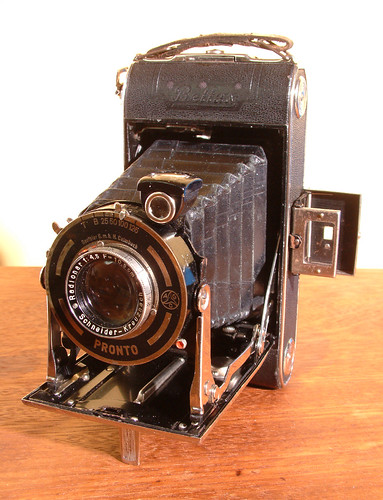Bettax

|
| Zeh Bettax (c1936) with a Radionar in a Pronto shutter. image by Dustin McAmera (Image rights) |
The Bettax is a folding camera made by Paul Zeh in Dresden in the 1930s; McKeown dates the first model, also sold as the Bobby, to 1931, and a second to 1936.[1] It takes eight images 2¼ x 3¼ inches on 120 film; some examples can be adjusted for sixteen half-frame pictures with a removable mask.[1] The main differences between the two models appear to be minor ones of style, and perhaps the use of more modern rim-set shutters in the later model. As often with folding cameras, a wide range of lens and shutter combinations was available: from Zecanar and Radionar triplets in simple shutters as pictured, to Tessar or Xenar in Prontor, Prontor II or Compur shutters.
The later model has a folding reverse-galilean viewfinder on the body as well as a Brilliant finder. Some examples have crosspieces in the viewfinder to show the half-frame view. It has a film winding key rather than a knob. Inside the film chamber, there are swing-out spool-holders at each end. The red window has a sliding cover. There are ⅜ inch tripod sockets on the side (at the opposite end from the key) and on the underside of the front door/lens bed. There is a spring suggesting that the camera should be self-erecting, though the example examined does not self-erect.
Like the Zeh Goldi, the later Bettax model was also supplied to Rodenstock, who sold it as the Weral or Werol[1]. A Rodenstock Ysar was one of the lenses available on the Zeh camera.
- Dimensions (height x width x depth): 166 x 90 x 45 mm (folded); depth unfolded = 128 mm.
- Weight (without film): 630 g
McKeown states that the Bettax was replaced with the Primus and the simpler Sport, in about 1937.[1]
Notes
- ↑ 1.0 1.1 1.2 1.3 McKeown, James M. and Joan C. McKeown's Price Guide to Antique and Classic Cameras, 12th Edition, 2005-2006. USA, Centennial Photo Service, 2004. ISBN 0-931838-40-1 (hardcover). ISBN 0-931838-41-X (softcover). p 1032. The example pictured has only one red window, and no half-frame crosspieces in the viewfinder, so was probably not intended to be adapted for half-frame use.
Links
- Zeca Bettax review at Lomography (in German)